Take a Bite of Sardinia: A Guide to Sardinian Food
Take a Bite of Sardinia: A Guide to Sardinian Food

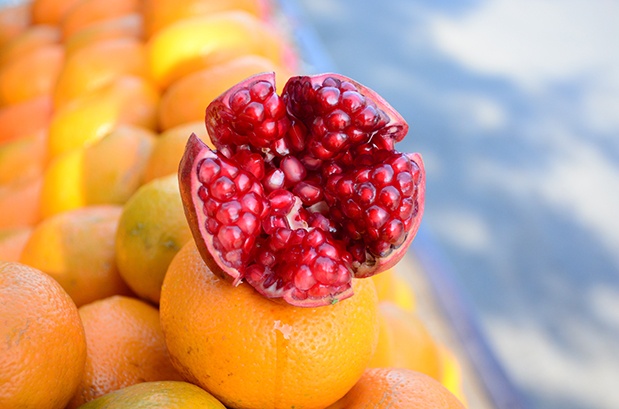
Sardinian food is so incredible! The island, which you can see up close on our Savor Sardinia bike tour, is an absolute paradise for food lovers. I’ve been collecting ideas and recipes over years traveling back and forth to the island, and always wanted to create an overview of this rich, intensely historical, traditional way of eating. Or, better yet, a “where-to-begin” guide to eating in this marvelous place.
Sardinian food ranges from seafood, freshly baked breads, olives, and wine to roasted suckling pig, cheeses, and ice cream. The distinctive flavors of Sardinia are not just Italian in origin but a complete mix and hybrid of various historical influences. Starting with the Phoenicians and followed by Carthaginians, Romans, Arabs, Moors, and Spanish, among others, the island was occupied by nearly every Mediterranean power for more than 2,500 years, until it became part of Italy in 1861. For a relatively small island, it’s amazing how much ingredients, recipes, and cooking methods vary from village to village.
Bearing all this in mind, here is a simplified Rough Guide to Sardinian Food.
Antipasti (Starters)
Typical starters include proscuitto, cheese, octopus, salami, olives, marinated vegetables, clams or mussels cooked alla marinara with white wine, garlic, and parsley; burred (dogfish marinated in a walnut and garlic sauce); and bottarga (salted, dried fish eggs of tuna or mullet) served in shavings with lemon and olive oil.
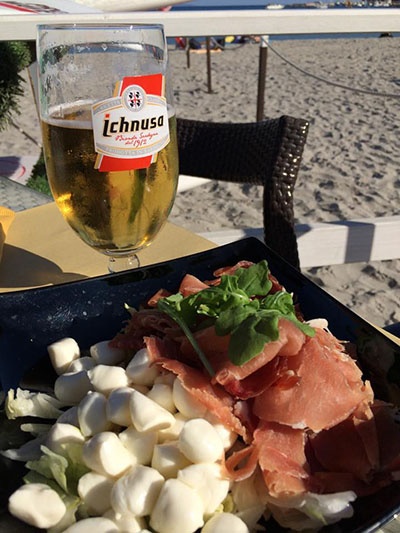
Primi (First courses)
These include sa fregula, a small round shaped pasta often served in fish broth with clams; malloreddus, small grooved pasta flavored with saffron and served with tomato and sausage sauce before being topped off with grated pecorino cheese; culingionis, ravioli made with semolina (potato and mint filling, but fillings depend on the region of the island); and panadas, a round pie filled with vegetables, meat, or eels. Panadas are so popular in Assemini that they have dedicated a festival to them.

Secondi (Second courses)
Usually a fish or meat dish. Traditional Sardinian meats are spit-roasted over a log fire then left to infuse on a bed of myrtle leaves. Baby lamb, goat, and rabbit are also very popular. The strong stomached may be brave enough to try sacordula, lamb intestines with peas tied into an intricate braid that is oven or spit roasted. Another specialty food is sanguinaccio, a pig-blood sausage sweetened with currants and sugar and served roasted or boiled.
Fish
Oddly enough, Sardinians did not eat a lot of fish until relatively recently. Perhaps fearing invasion or to escape the domination of invaders who settled along the coasts the population often sought refuge in the mountainous interior of the island where they developed a culinary tradition based on the rearing of pigs, goats, and sheep and large crops of wheat. Now, as if to make up for lost time, the fish in Sardinia is a delicacy not to be missed. At the very least you should try Burridaa Sa Casteddaia (Burrida alla Cagliaritana), an antipasto of fish which is served in Cagliairi. Its main ingredient is dogfish, which is marinaded in walnuts, vinegar, and spices for 24 hours.
Lobster is legally in season from March to August. It’s a specialty of Alghero where it is served as Aragosta alla catalana with tomato and onion. Cassola and Zuppa alla Castellanese are fish soups, the latter with more that a dash of tangy tomato. If you want something more unusual you could try fried sea anemones (orziadas) or sea urchins (ricci). You will also find clams (often served with fregola, a Sardinian pasta), tuna, octopus, king prawns, crab, sea bream, eel, and many other Mediterranean seafood and fish in abundance on Sardinian tables.

Meat
Sardinians eat a lot of meat and it is hardly surprising given the quality and variety of the products on offer. Favorites include suckling pig (SuPorcheddu) with myrtle leaves, roast baby lamb, and lots of horse meat. Traditionally meat is cooked on open fires on a spit. If you are lucky you may taste meat cooked in a more unusual way (Incarralzadu). The meat is placed in a hole in the ground and packed in with myrtle leaves, earth is piled on top of the leaves and a fire is lit on top of the sealed hole. The meat cooks slowly underground for several hours infused by the delicate flavor of myrtle. Mutton has long been a staple of the Sardinian diet, and is often served in broth with crisp bread. Pecoracappotto (ewe undercover) is a rich mutton stew. The meat was cooked by peasants with beans and pork fat in the same pot in order to conceal the meat which they had probably stolen. Sardinians also enjoy game birds, rabbits, and wild boar. The local sauce al mirto, made with red myrtle, is a common accompaniment/sauce to any meat.
Cheese
If you ask Italians to name a food from Sardinia, most will probably answer the sheep’s cheese, pecorino (pecora is Italian for sheep). The shepherds of Sardinia have raised the process of cheese making to an art. They have been making cheese for 5,000 years and Sardinia now makes 80 percent of Italy’s Pecorino. The strength of a cheese depends mainly on the length of time it is seasoned (stagionato). The longer the seasoning process, the fuller the flavor. The softer, milder cheeses are seasoned for less than six months whereas the spicier, more manly cheeses are seasoned for up to 24 months. It’s also common to grate pecorino over pasta in Sardinia as an alternative to parmesan. Sardinia also boasts delicious goat’s cheeses, such as ircano and caprino, as well as ricottas and herb cheeses like canestrati. The soft crema del Gerrei is a combination of goat’s milk and ricotta.
If you are brave, you could try casu marzu. This is a highly pungent sheep’s cheese that is deliberately infected with the piophilacasei cheese fly to hasten fermentation (I’m not making this up!) Apparently, the cheese has decomposed a stage too far if the fly larvae are actually dead, so when eating it, you have to watch out for leaping maggots. It’s illegal to sell this cheese but shepherds often keep a personal supply that you might be lucky (?) enough to taste.
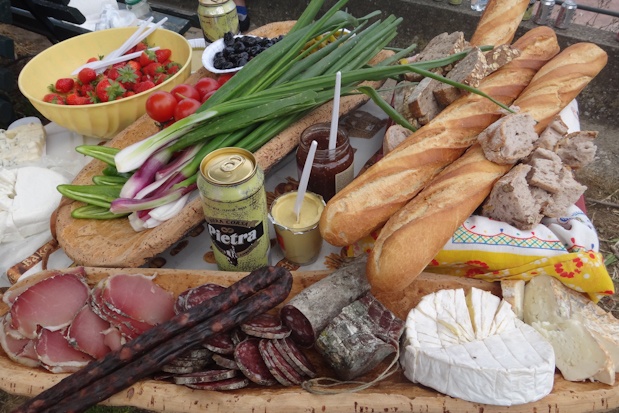
Bread
There are over 200 types of bread in Sardinia! Wow. One of the most famous is the carasau known also by the name carta da musica (music paper), because it is so thin. It is a simple bread made from durum wheat and water that is double baked in a wood fired oven. You will find this crispy bread in most restaurants and trattorias. Carta da Musica is often sprinkled with oil and salt and put in the oven for a few moments. When made in this way, it’s known as guttiau.
Pane frattau is the same bread topped with tomato sauce, grated pecorino, and a boiled egg. Another type of bread, su civraxiu (from the Latin word “”ciboria”” for flour), is found particularly in Oristano, Iglesias, and the plains of Cagliari. It’s a round loaf with a crispy crust on the outside and a soft white bread on the inside. This bread was first introduced to Sardinia when the Romans were in power. It is excellent for bruschetta and antipasto.
Coccoi, with a hard crust and very soft inside, is most common in the Campidano area. Traditionally this bread was used during festive periods and weddings. In many areas, it was used as a decoration when the women of the villages baked it in the shape of flowers, artichokes, and other symbolic forms. Spianata or spianada is also common and similar to Middle Eastern Pita. In Sassari, you will find farinata made from chickpea flour, originally a Ligurian bread imported to the island centuries ago. The Spanish introduced panadas which are small bread parcels filled with a whole range of fillings from minced lamb or pork to eel.
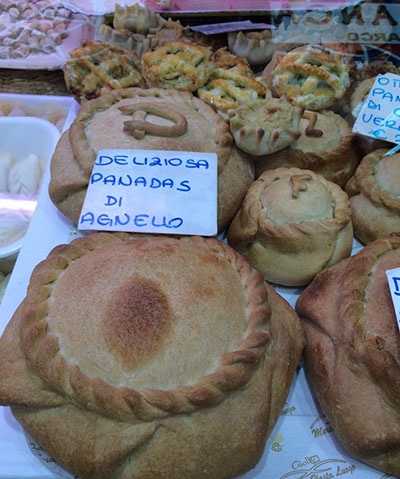
Pasta
Like all Italian regions Sardinia boasts its own pasta specialities. During you trip, be sure to try Malloreddus (also called maccarones or cravaosorciciones). These are tiny gnocchi made of semolina flour and water, sometimes with saffron added. They take longer than most dried pastas to cook; 15 to 20 minutes. One of the traditional uses of this type of pasta is to serve it with sausage and tomato sauce cooked with garlic, basil, a hint of saffron, and grated pecorino. You’ll also enjoy Curlgiones, a type of ravioli often filled with potatoes, pecorino cheese, and mint and served in a tomato sauce.
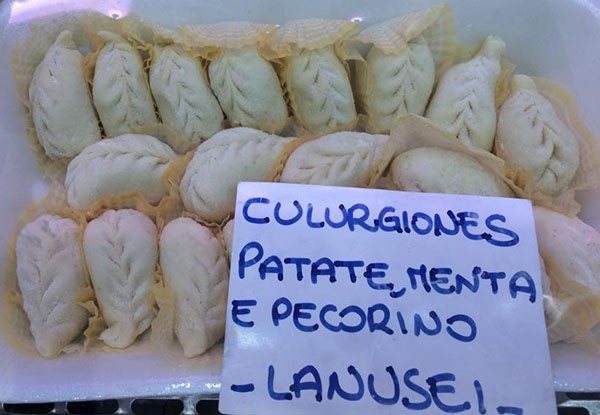
Maccarones furriaos are strips of pasta folded and topped with a sauce and melted cheese. Maccarones de bussa are traditionally shaped by wrapping the pasta around knitting needles. Pillus is a small ribbon pasta and filendeu is a fine noodle pasta served in soups.
Desserts
The majority of Sardinian desserts are based on eggs, sugar, honey, ground almonds, flour, a touch of orange flowers, and saffron. Pastry here is mouthwatering yet simple. Saba (wine must) is sometimes used as an ingredient, as is fresh pecorino cheese, which is used to make Sebadas, Pardulas, and Copulettas. Many Sardinian sweets are really pretty, decorated with icing sculptures, colorful pralines, or tiny golden leaves and petals. You should try the Sardinian take on Amaretti biscuits called Sospiri (Sighs) made with a dash of Sardinian Mirto (a myrtle flavored liqueur).
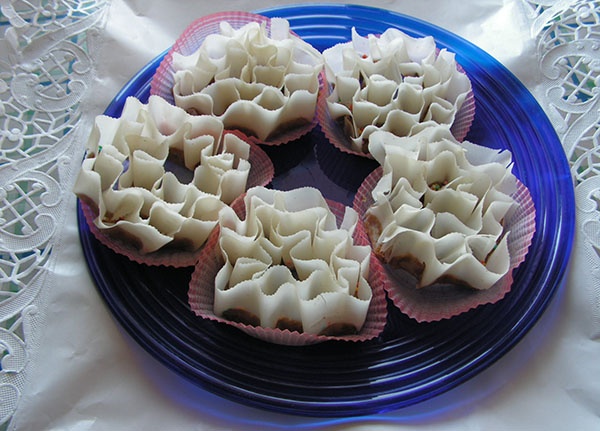
Wine
Sardinian wines are not as well known as they should be. Since the 1970s, thanks to aid from the European Community and in response to a growing demand for good wines from visiting tourists, many wine producers have focused on improving the quality of their vintages. Today, despite its hilly topography, Sardinia has one DOCG wine, Vermentino di Gallura, 19 DOC zones and 15 IGT zones. Sardinia’s best known red grape is Cannonau, a relative of the Granacha grape that originally came from Spain, and its most famous white grape is Vermentino, a dry white variety grown primarily in northern Sardinia that is also of Spanish origin.
Another red variety that is becoming increasingly popular is Carignano. Known as Carignan in France, this variety achieves its greatest potential in the Sulcis area in southwestern Sardinia where it produces a spicy and rich wine known as Carignano del Sulcis. Sardinia’s vineyards also include a wide range of international varieties such as Cabernet and Chardonnay together with lesser-known local varietals such as Monica, Bovale Sardo, and Nuragus. All of these varieties, particularly the local varieties, have contributed to enhancing the reputation of Sardinian wines on the international market.
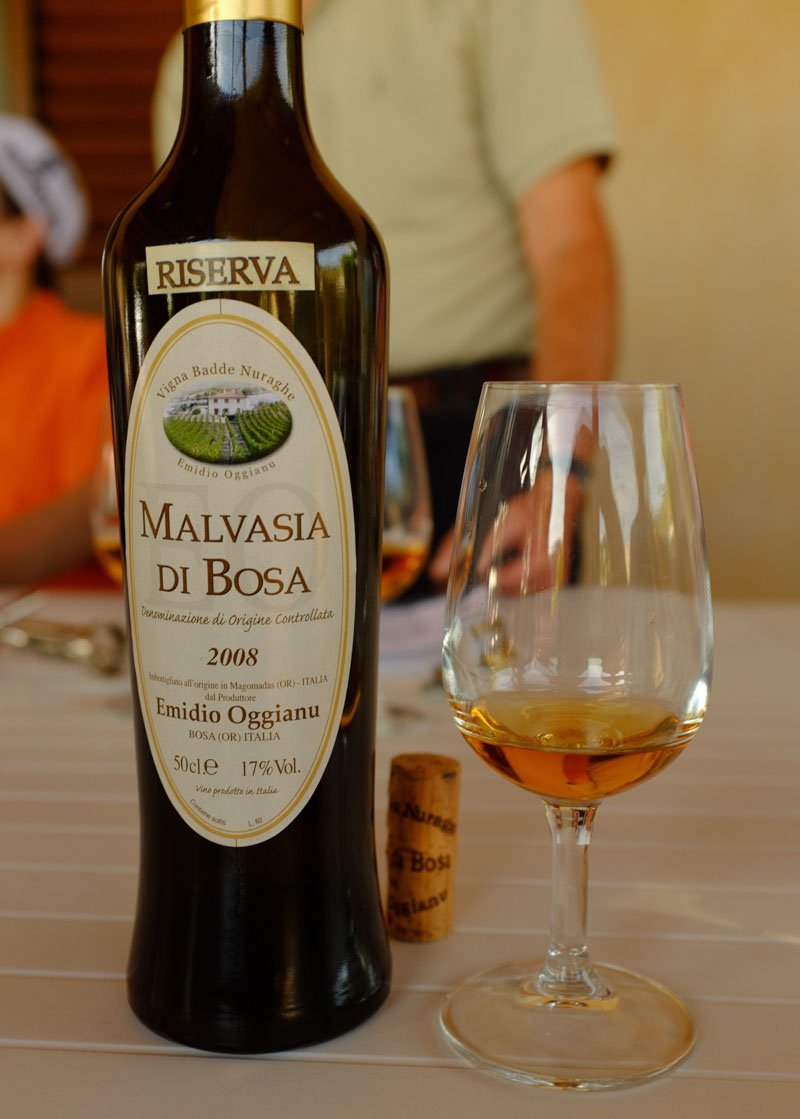
Spirits
Sardinia’s most famous liqueur is mirto, a spirit made from the purple fruit of the myrtle bush. You will also find spirits infused with prickly pears, corbezzolo (an autumnal plant related to strawberries), and basil. Sardinia also makes its own version of limoncello, similar the the drink made on the Amalfi coast.
At 40 percent proof, the fiery filu e ferru (wire and iron) pulls quite a punch. It’s made from a distillate of grape skins.

The Sardinian secret to longevity?
There’s a great Italian expression (not particularly Sardinian but heard throughout Italy) that says: “A tavola non si invecchia mai!” One never ages at the dinner table!
Along with folk who live in Okinawa, Japan and Costa Rica’s Nicoya Peninsula, Sardinia’s inhabitants have a life expectancy exceeding that of all industrialized nations. A disproportionate number of Sardinians make it to a hundred and beyond. No doubt genetics are at work here (Sardinians lived a fairly isolated existence for much of modern history) but as well as passing on their good genes it is clear that Sardinians take pride in passing down the wisdom of their traditional diet that is rich in local vegetables and legumes and low in processed fats and sugars. We would all do well to take a page out of their book.
I personally hope you get a chance to join us on a bike tour on this most enchanting isle and enjoy the simplicity of the Sardinian cuisine as all that great food—combined with days of incredible cycling—will enrich your mind and nourish your body and soul.
Learn more about our Savor Sardinia bike tour and join us for culinary delights and unforgettable sights!
{{cta(‘77115cf4-2bc4-432e-806d-2f06cf31e0d3’)}}
